When I completed my first mystery novel, Hung Out to Die, I quickly discovered that the novel would not stand alone. A synopsis was required.
As a freelance journalist and communications specialist, I’ve put together a lifetime of pitches and proposals. Still, I spent some time reading up on what makes a successful synopsis. Then I wrote my own.
My synopsis does not follow the traditional pattern, but most of the required elements are there. I wondered if this would pass muster. Overall, the people I shared the synopsis with liked it. One person didn’t like it at all and said it would never pass muster with publishers. I took a long hard look and, respectfully, disagreed.
This was nerve-wracking. I knew it would be easier to simply follow the path well taken, but I felt I needed to branch out. I entered a shorter version of my synopsis in the Synopsis Skirmish contest – and won. The judge (one of my favorite people) had this to say: The author’s handling of voice in this synopsis is so powerful, it made me want to read the novel right away. The synopsis is unusual and intriguing—a winning combination.
When the acquisitions editor at BWL (another of my favorite people) reached out to me requesting a full copy of my manuscript, she noted, “We were quite taken with your synopsis.”
The synopsis issue has driven home to me the need to listen to yourself, that inner voice that knows you better than anyone. At the same time, it has taught me more about flexibility and being open to feedback. There is nothing as helpful as constructive criticism (whether accepted or not) and editors are worth their weight in gold.
I thought I’d share my synopsis – my very first – with you. I’d love to know what you think.
Synopsis
Hung Out to Die: A Riel Brava Mystery
By donalee Moulton
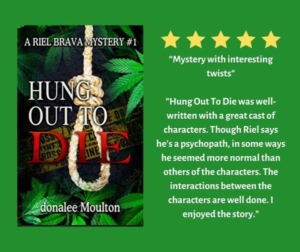 Let’s start with the obvious.
Let’s start with the obvious.
Meet Riel Brava. Attractive. Razor-sharp. Ambitious.
Riel, born and bred in Santa Barbara, California, has been transplanted to Nova Scotia where he is CEO of the Canadian Cannabis Corporation (CCC). It’s business as usual until Riel finds the company’s comptroller hanging by a thread. Actually, several threads. It doesn’t take the police long to determine all is not as it appears.
Let’s dive beneath the surface.
Meet Riel Brava. Observant. Cautious. Psychopathic.
Not the Dexter-Hannibal Lecter-Norman Bates kind of psychopath. The kind who live and work among us, mostly unnoticed, often successful, always on full alert their differences will be uncovered. Riel is personable, even charming. He’s keen to understand how the human mind works, so he’ll blend in. After all, his goal is to be president of the United States. (An aspiration that will feature in future books.)
Let’s talk plot.
So Norm Bedwell has apparently hanged himself in his office at CCC. Emphasis on apparently. It takes Detective Lin Raynes mere minutes to suspect the obvious is deceiving and what appears to be death by suicide is actually a murder. Over the course of 13 chapters (there is also an introductory chapter), he works to uncover and discover who would want Bedwell dead and how they could have pulled the murder off.
He’s not alone. In an unusual pairing, Raynes and Riel work together to chase down leads – the bully who tortured Bedwell’s son at school, the mysterious orange truck that belongs to no CCC employee but was parked in the company lot the night Bedwell was murdered, the employee, who despite stringent security measures, has managed to steal weed from CCC and start a healthy little illegal business.
Raynes manages to engage Riel, albeit reluctantly, in the hunt for Bedwell’s killer, and in the process, the seeds of an unexpected and unusual friendship are sown. (These seeds will blossom in subsequent books.)
Various motives are explored through a number of suspects – revenge, fear, greed – but ultimately, it’s love that becomes the reason Norm Bedwell no longer lives. Unfortunately, the evidence is circumstantial. Raynes and Riel concoct a scheme to draw a confession out of the killer, but that plan is never put into place. Instead, Riel finds himself on the receiving end of a rifle in the ribs and a long drive to the middle of Nowhere, Nova Scotia.
Let’s look at the core cast of returning characters. You’ll like them all.
Tiffany Brava. Riel’s wife and loyal supporter. Somewhere in the recesses of her mind, Tiffany knows Riel is not quite like everyone else – and why. For now, that door is closed. What’s openly obvious is her affection for her husband, her loyalty, and her acumen. Don’t count Tiffany out as the dumb blonde. Oh yes, she’s vegan.
Franklin Raynes. The Halifax Police Department’s lead detective on this case is Black, quintessentially Nova Scotian, and a consummate charmer. He can read the room and respond accordingly. He takes a shine to Riel, and also realizes how helpful the psychopath can be in solving this case. (Yes, Lin Raynes is privy to Riel’s deepest secret, but he doesn’t admit it to his new friend – just yet.) Oh yeah, Raynes also does this thing with his left eyebrow.
Senator John Williams. Tiffany’s dad | Riel’s father-in-law is the Democratic Senator for District 19. A seasoned and senior politician, Williams is a co-owner of CCC, although it’s not an asset he talks about with constituents. He’s brusque, except where his daughter is concerned, and well connected, even in Canada.
Zahra Bashir. A practising Muslim and savvy TV reporter who’s always on the lookout for the inside scoop. Bashir makes many of the other characters very nervous despite her friendly demeanor.
David Clements. The recreational cannabis sector in Canada is heavily regulated. Clements is the federal DOJ’s contact for Riel. Their relationship is one of power and powerful expectations. Clements holds that power. A minor character, Clements plays an important role. He’s the first person to use a special word.
There are other characters introduced in this book who will also return but play a smaller role in this mystery.
Let’s look at the cast of characters in the book. You won’t like them all.
– Faye Bedwell, distraught and disrespected wife of Norm Bedwell.
– Bran Bedwell, the Bedwell’s 12-year-old son who takes a liking to Riel. Good grief.
– Thorne, media consultant and very protective of Riel.
– The bully and his parents.
– The poor sod who owns the orange truck.
– The killer.
What’s familiar about Hung Out to Die to make mystery fans feel at home.
– It’s fast-paced.
– It lays out a path of breadcrumbs that lead, ultimately, to the killer. First, of course, the path branches off in several misdirections.
– It creates suspense.
– It builds understanding and affection for key characters.
– It leaves readers wanting more.
What’s novel about the book to make the mystery stand apart and readers turning pages.
– It introduces a unique character that, ironically, we empathize with
– It’s funny as hell
– It’s written by an award-winning journalist who knows both how to tell a story and how to use words to maximum effect
Riel Brava: Vital Statistics.
Height: 6’1
Weight: 165 pounds
Waist: 35 inches
Age: 37
Spouse: Tiffany, the vegan
Job: CEO, Canadian Cannabis Corp.
Location: Elmsdale, Nova Scotia, Canada
Ambition: President of the United States of America
Favorite food: Donairs (definitely not vegan)
Top personality trait: Psychopath
Burning question: What the hell’s a chunderf**k
Synopsis Workshop
If you’d like to learn how to craft a successful synopsis, sign up for donalee’s online workshop on February 11 & 18, 2025.
This workshop will explore:
* what should go in a synopsis and why
* why and how to break the rules with care (and flair)
https://donaleemoulton.com/crafting-a-synopsis
About donalee
donalee is a professional writer from Halifax, Nova Scotia. Her byline has appeared in over 100 publications across North America. Her most recent book Conflagration! won the 2024 Daphne du Maurier Award for Excellence in Historical Mystery Suspense. Her other books include a murder mystery based in Nova Scotia and a non-fiction book about effective communications, and she has more coming out this year. She is a longtime educator and currently offers a variety of editorial services and workshops to help authors hone their writing and get it published.
You can catch up with her on Bluesky, Facebook, Instagram, and LinkedIn.
 Clicking Our Heels – Crime We’ve Avoided Writing About
Clicking Our Heels – Crime We’ve Avoided Writing About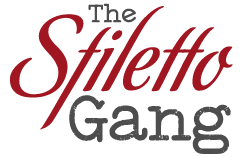
 By Lois Winston
By Lois Winston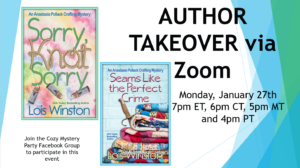 P.S.: On Monday evening, January 27th at 7pm ET (6pm CT, 5pm MT, and 4pm PT), I’ll be the guest of the Cozy Mystery Party Facebook Group, hosted by Heather Harrisson and Shawn Stevens. If you’d like to join in for a fun hour + of all things murder, mayhem, and cozy mysteries (there will be prizes and surprises!), join the group at
P.S.: On Monday evening, January 27th at 7pm ET (6pm CT, 5pm MT, and 4pm PT), I’ll be the guest of the Cozy Mystery Party Facebook Group, hosted by Heather Harrisson and Shawn Stevens. If you’d like to join in for a fun hour + of all things murder, mayhem, and cozy mysteries (there will be prizes and surprises!), join the group at 
 Let’s start with the obvious.
Let’s start with the obvious. 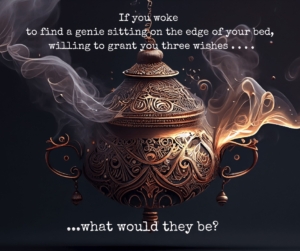



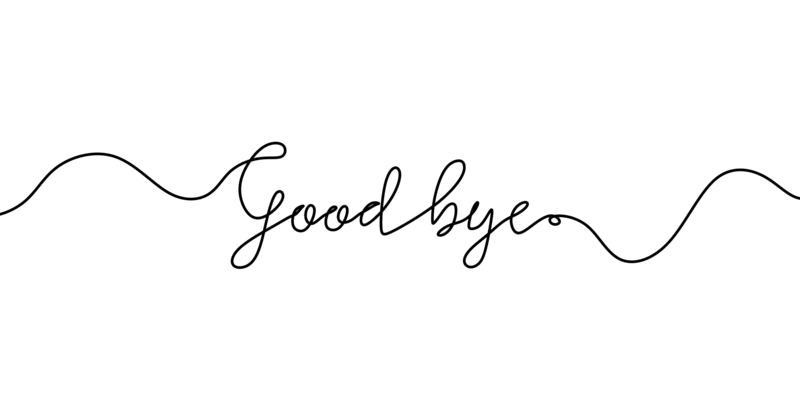 Thank you guys for letting me participate on The Stiletto Gang blog. It’s been a wonderful experience and I’ve learned a lot from all the authors in this group.
Thank you guys for letting me participate on The Stiletto Gang blog. It’s been a wonderful experience and I’ve learned a lot from all the authors in this group.



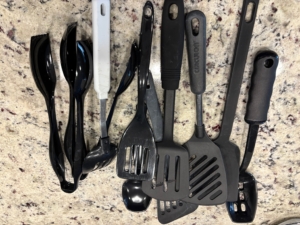 Calling All Black Utensils – Or Else! by Debra H. Goldstein
Calling All Black Utensils – Or Else! by Debra H. Goldstein
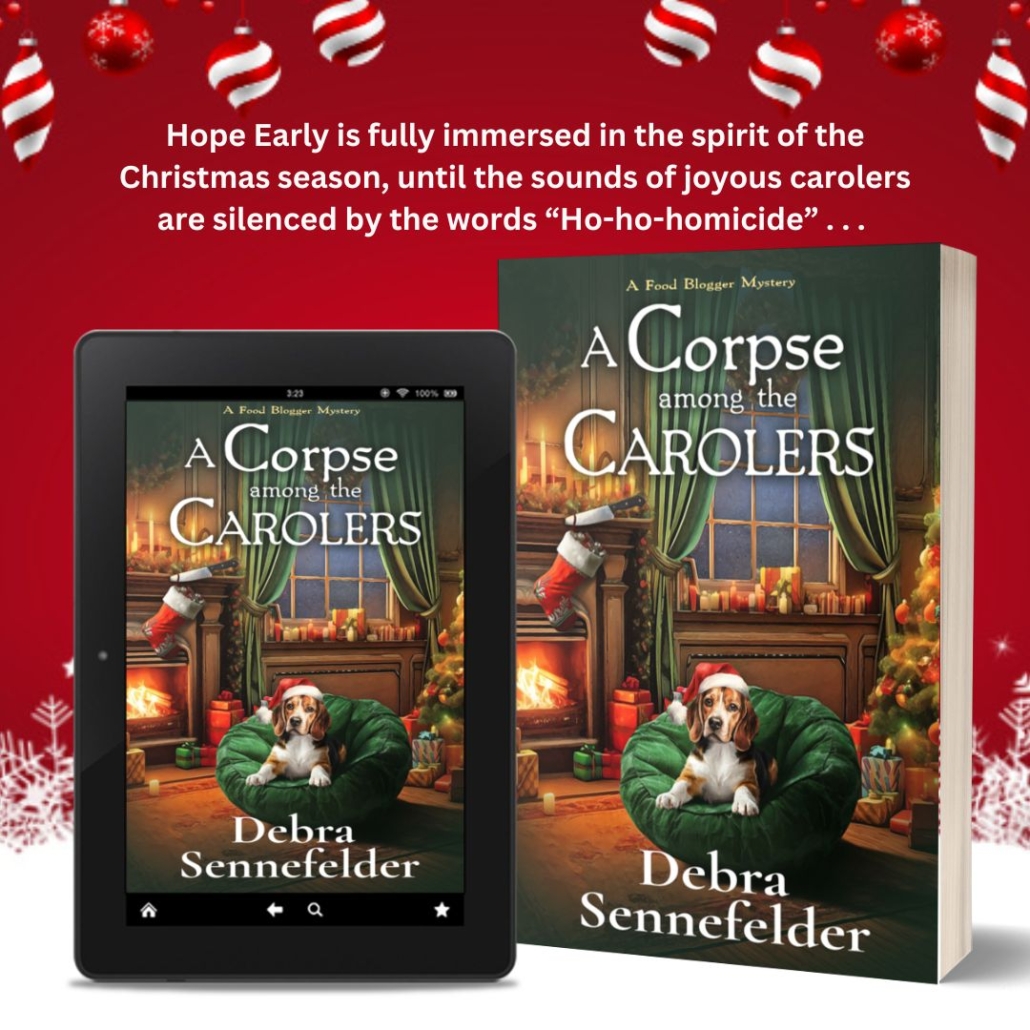
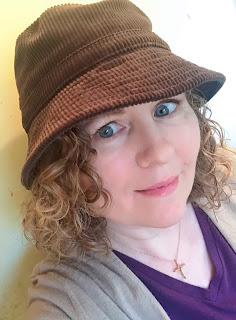 Debra Sennefelder is the author of the Food Blogger Mystery series and the Resale Boutique Mystery series. She lives and writes in Connecticut. When she’s not writing, she enjoys baking, exercising and taking long walks with her Shih-Tzu, Connie. You can keep in touch with Debra through her
Debra Sennefelder is the author of the Food Blogger Mystery series and the Resale Boutique Mystery series. She lives and writes in Connecticut. When she’s not writing, she enjoys baking, exercising and taking long walks with her Shih-Tzu, Connie. You can keep in touch with Debra through her